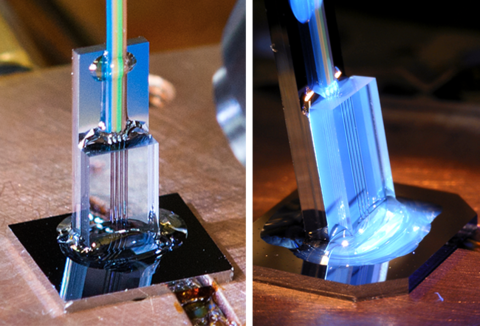Photonic Thermometry

The Technology
NIST’s revolutionary approach to measuring heat, temperature and related quantities makes use of a variety of sensors that detect changes in the properties of light caused by thermodynamic conditions.
NIST’s photonic thermometers send light beams of known wavelength through silicon strip block in channels a couple of hundreds of nanometers wide. In one design, a channel is adjacent to a ring resonator. The temperature of the silicon affects both the dimensions and thermo-optic properties of the resonator, with a resulting shift in output wavelength. In another design, the channels contain air holes to create Bragg mirrors. Changes in temperature alter the Bragg spacing and thus the wavelengths transmitted or reflected by the mirrors.
A related technology uses photonics to measure humidity — technically, dew point. NIST researchers are testing a new kind of sensor: an optical fiber that curls in dry air and straightens in moist, which changes the properties of the light passing through the fiber.
Yet another NIST chip-scale instrument is a bolometer. It measures optical power by detecting the amount of heat produced by electromagnetic radiation incident on a cluster of vertically aligned carbon nanotubes that absorb 0.999% of incoming light. One electrical-substitution design constantly monitors the agreement between the heat content of the absorber and the same amount of heat generated by an on-board electrical heater. Because the output of the electrical heater is known to extraordinary accuracy, it provides a sensitive check on the absorbed heat energy measured.
Advantages Over Existing Methods
The current global “gold standard” instrument for temperature measurement is the platinum resistance thermometer. In a typical design, delicate coils of platinum are wound around a central rod, and then enclosed in slender, fragile glass tubes or metal cladding. The instruments can be affected by humidity and mechanical shock, are very difficult to miniaturize, and can require frequent time-consuming and expensive recalibrations to ensure peak performance. As a result, they are ill-suited to a variety of industrial applications.
By comparison, NIST’s photonic technologies are low-cost, lightweight, portable and resistant to the interference of magnetic and electrical fields. They can be deployed in a wide variety of settings ranging from controlled laboratory conditions to a noisy factory floor to private residences. Because the effects they measure are governed by the laws of quantum physics, most instruments need no calibration.
Applications
Ultrasensitive measurements of temperature are critical to many industries, including aerospace; green chemistry; fossil fuel energy production; environmental monitoring in office, laboratory and manufacturing settings; and biomedical devices designed to transmit data to health care providers.
Chemical, pharmaceutical and oil-and-gas companies must ensure that reactions occur at exactly defined temperatures. The same applies to a host of other applications, such as: forming strong alloys, controlling metal welding, monitoring the internal temperature of critical manufacturing machinery, and preserving valuable medicines and vaccines.
Photonic dew-point sensors could be important for uses from monitoring industrial-scale baking to diagnosing lung disease, controlling chemical and pharmaceutical processes, manufacturing high-end electronics and more. Sensors like these could be built into bridges and buildings for real-time monitoring of humidity, which affects the aging of these structures.
NIST’s bolometer designs are being incorporated into satellites for measuring the power of light from the Sun that falls on the Earth in watts per square meter, a quantity that is critically important to weather and climate science research.
Key Papers
N.A. Tomlin, C.S. Yung, Z. Castleman, M. Denoual, G. Drake, N. Farber, D. Harber, K. Heuerman, G. Kopp, H. Passe, E. Richard, J. Rutkowski, J. Sprunck, M. Stephens, C. Straatsma, S. Van Dreser, I. Vayshenker, M.G. White, S.I. Woods, W. Zheng and J.H. Lehman. Overview of microfabricated bolometers with vertically aligned carbon nanotube absorbers. AIP Advances. May 7, 2020. DOI: 10.1063/5.0004025
J. Lehman, A. Steiger, N. Tomlin, M. White, M. Kehrt, I. Ryger, M. Stephens, C. Monte, I. Mueller and J. Hollandt. Planar hyperblack absolute radiometer. Optics Express. 2016. DOI: 10.1364/OE.24.025911
D. Harber, Z. Castleman, G. Drake, S. Van Dreser, N. Farber, K. Heuerman, J. Rutkowski, A. Sims, J. Sprunck, C. Straatsma, I. Wanamaker, W. Zheng, G. Kopp, E. Richard, P. Pilewskie, N. Tomlin, M. Stephens, C. Yung, M. White and J. Lehman. Compact total irradiance monitor: flight demonstration. Proceedings of SPIE 11131, CubeSats and SmallSats for Remote Sensing III. Aug. 30, 2019. DOI: 10.1117/12.2531308
C.S. Yung, N.A. Tomlin, C. Straatsma, J. Rutkowski, E.C. Richard, D.M. Harber, J.H. Lehman and M.S. Stephens. BABAR: black array of broadband absolute radiometers for far infrared sensing. Proceedings of SPIE 10980, Image Sensing Technologies: Materials, Devices, Systems, and Applications VI. May 13, 2019. DOI: 10.1117/12.2516047
Z. Ahmed, N.N. Klimov, T. Purdy, T. Herman, K. Douglass and R. Fitzgerald. Photonic thermometry: upending 100 year-old paradigm in temperature metrology. SPIE Proceedings. April 12, 2019. DOI: 10.1117/12.2505898
https://doi.org/10.1117/12.2176666
N.N. Klimov, T.P. Purdy and Z. Ahmed. Towards replacing resistance thermometry with photonic thermometry. Sensors & Actuators A. Dec. 2, 2017. DOI: 10.1016/j.sna.2017.11.055
N.N. Klimov and Z. Ahmed. Fabrication and testing of photonic thermometers. Journal of Visualized Experiments. Oct. 24, 2018. DOI: 10.3791/55807
N.N. Klimov, T. Purdy and Z. Ahmed. Chip-Packaged Silicon Photonic Nanoscale Thermometers. Proceedings of CLEO-2016. June 2016. DOI: 10.1364/CLEO_AT.2016.AW1J.6
T.P. Purdy, K.E. Grutter, K. Srinivasan, N.N. Klimov, Z. Ahmed and J.M. Taylor. Optomechanical quantum correlations. Proceedings of CLEO-2017. May 2017. DOI: 10.1364/CLEO_QELS.2017.JTh3G.4
N.N. Klimov, T. Purdy and Z. Ahmed. On-chip silicon photonic thermometers: from waveguide Bragg grating to ring resonator sensors. Proceedings of SPIE. May 13, 2015. DOI: 10.1117/12.2176666
N.N. Klimov, T. Purdy and Z. Ahmed. On-chip integrated photonic thermometers. Sensors & Transducers. Aug. 2015.
Key Patents
Z. Ahmed et al. Optical temperature sensor and use of same. United States Patent US 9,726,553. Aug. 8, 2017.
J. Lehman et al. Radiometer and method for use of same. United States Patent US 9,291,499. March 22, 2016.
Contacts
-
(301) 975-5875
-
(301) 975-3517
-
(303) 497-3654

